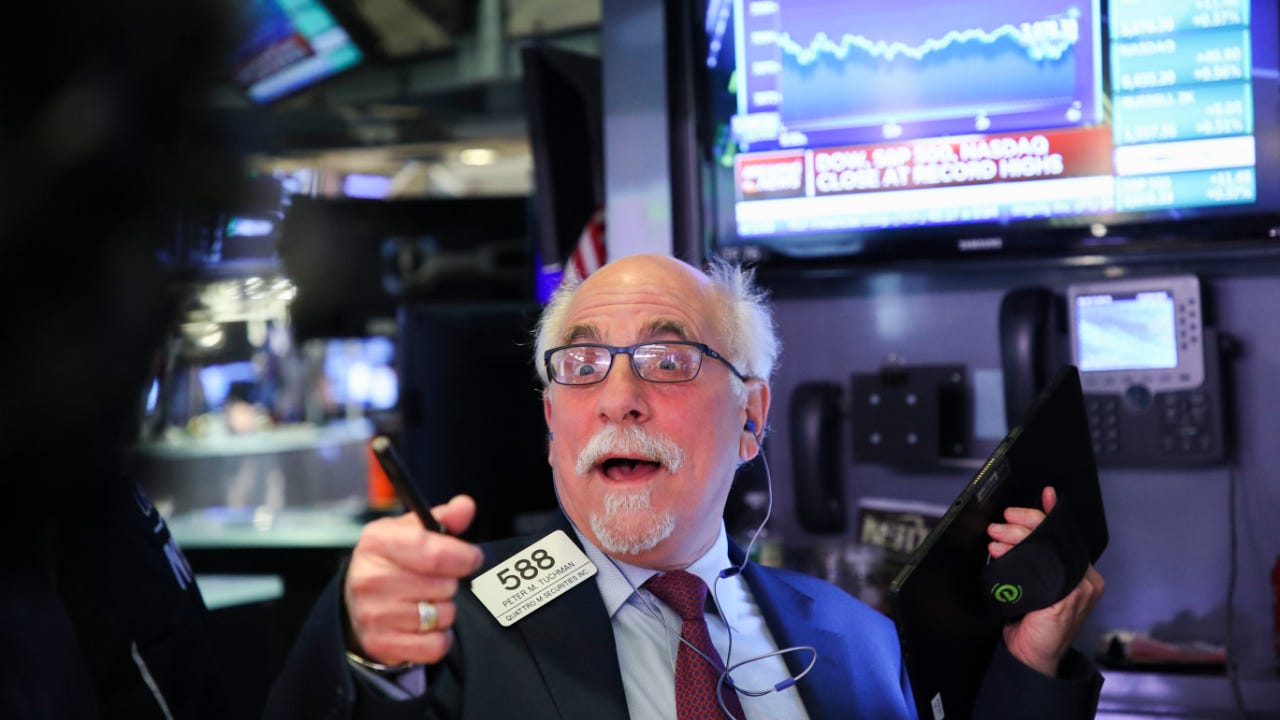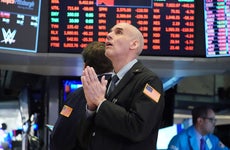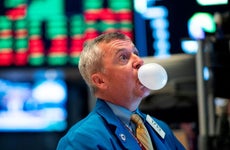5 sure-fire signs of a stock market bubble

The Bankrate promise
At Bankrate we strive to help you make smarter financial decisions. While we adhere to strict , this post may contain references to products from our partners. Here's an explanation for .
Despite widespread predictions of a recession and other doomsday gloom at the start of the year, the stock market ended 2023 in a furious rally, with the Standard & Poor’s 500 index up more than 22 percent since January. The run-up really kicked off in early November, with the S&P gaining over 14 percent in just seven weeks.
While stocks have shown a serious bounce since January, this turn-around resilience is giving some investors pause. Could we be in a stock market bubble? Could stocks be priced so high that they’re not just overvalued but actually “hot-air-balloon-leaving-the-earth’s-atmosphere” overvalued? In bull markets that seem to go on endlessly, it’s important to not become complacent.
Here are five signs to look for to judge whether we’re in bubble market territory and what we’ll likely see if we’re there.
What is a stock market bubble?
A stock market bubble is a speculative frenzy when stock prices vastly exceed the fundamental value of the companies underlying them. A market as a whole can also be in a bubble if traders buy assets seemingly regardless of their value. Similarly, individual stocks can be in a bubble when investors bid up their prices well beyond what’s justified by the business performance.
A stock bubble is not merely overvaluation, which can occur even during normal periods as markets become mildly overextended. Instead, a bubble is a period of massive overvaluation, when speculators become inflamed by “animal spirits” and heedlessly bid up stocks. Often these periods are driven by a new business story that promises to revolutionize the world.
Watch for these tell-tale signs of a stock market bubble
There’s an old saying on Wall Street: “No one rings a bell at the top.” It means that only in retrospect does it become obvious for most market participants that the market has peaked.
But while there may be no bell at the top, observant investors can pick up on many indicators that show when the market is in nosebleed territory. You’ll want to see many of these factors working together to produce a euphoric bubble, as you weigh your options for how to keep your portfolio protected in the event that the hot market finally cools off — or worse, the bubble pops.
1. A story has captured the market’s imagination
A compelling story is one of the best frameworks for creating a stock bubble. The dotcom bubble of the late 1990s had one: “The internet changes everything.” The housing bubble of the 2000s had one: “Real estate never declines in price.” Even the 19th century’s railway mania promised that the massive benefits of the railroads would transform travel and transportation.
These so-called story stocks promise to transform the world, and while the promised benefits may ultimately arrive, they tend to take a lot longer than the stock promoters would have you believe.
The benefits of the internet eventually arrived, but not before effectively destroying hundreds of dotcom companies that had poor business models. And even the survivors get caught up in the frenzy, with the stocks of eventual leaders such as Amazon being bid up to astronomical levels before eventually falling along with the other stocks in the overhyped sectors.
Where we see it today: There’s not one widespread story that’s captured the imagination the way that dotcom stocks did, but a few sectors are bubblicious: electric vehicles, self-driving cars, software-as-a-service (SaaS) companies, artificial intelligence Uber and cryptocurrency all have similar story elements that promise radical transformation and charge a very high price of admission.
2. Prices rise regardless of news
The story is important because it offers a theme to build investors’ hopes and dreams on. It also provides a guide for what’s to come and how the new transformational industry might develop. But what if reality differs from the story? Investors will surely adjust their expectations, right?
In a bubble, it’s as if every bit of information verifies the story, so stock prices rise regardless of the news. A company hits its earnings estimates? The stock climbs. And if it misses earnings estimates by a mile? It still climbs. The story stocks seem unbreakable, and they are for a time.
And so sharp-eyed investors are calibrating reality to the story in order to see if they fit. When stocks rise but the long-term future looks clearly worse, long-term investors should be extra careful.
Where we see it today: Stocks have climbed a lot amid the pandemic, but they’re pricing in a future recovery and in many cases are not above their pre-pandemic prices. So, valuations on stocks as a whole don’t look euphoric. In fact, many smaller stocks are well off their highs.
But look at individual sectors or companies and you’ll see some of them rising to high valuations despite mediocre or poor news. For example, stocks of tech and AI companies of electric vehicle makers have captured the market’s fancy, and a few companies with limited or no production are valued in the tens of billions. While many of these companies may prove valuable, their price is likely overinflated compared to what they’re capable of today.
3. Other asset prices are soaring, too
Often in a bubble market, it’s not just stocks that are soaring; it’s other assets, too. Flush with cash from their stock successes, a booming economy or easy money, speculators rush out to buy other highly risky assets.
During these times you may see the prices of collectibles skyrocketing. Promoters may try to hype up “new asset classes” by highlighting how investible sports cards are, or how art from the great masters never seems to decline in value. Assets such as these produce no cash flow and so turning a profit hinges entirely on finding someone else to pay more for them than you did.
And the definition of “investible” assets continues to grow: luxury handbags, shoes, Pokemon cards Beanie Babies, wine, video game cartridges, digital art through NFTs and the list goes on and on.
Where we see it today: With thousands of possible examples, cryptocurrencies have seen a flood of interest as speculators and promoters rush to the space to cash in. NFTs are riding this wave as well. Cryptocurrency has a total market valuation of around $1.62 trillion as of January 2023, with Bitcoin holding the lion’s share of that figure. Of course, it’s not just digital assets that have piqued interest — shoes and handbags have seen soaring prices lately, too.
4. New traders say that old investors ‘don’t get it’
When the taxi driver, the hair stylist and the grocery clerk are giving you investing tips, it’s a good sign that an investment thesis has spilled over to the mainstream and is attracting less sophisticated retail traders looking for a buck. And they may well succeed – for a period of time.
In the rush to build hype, breathless promoters will say “this time it’s different.” But it rarely is.
This new breed of trader will explain to you why Warren Buffett doesn’t “get” the new paradigm and that Buffett and other similarly “old school” investors are behind the curve. This new crowd may have been trading for just a few months, but they insist they understand the markets.
Yet it was Buffett who endured similar barbs from inexperienced traders in the dotcom bust and then came through it all. He avoided much of the housing debacle, too. Buffett was perched on a war chest and took advantage of ailing banks that needed cash and confidence during the 2008 financial crisis.
Pro gamblers love popular horse races such as the Kentucky Derby, because they bring easy money to the track, allowing the real handicappers to take it. So it is with investing, too.
Where we see it today: AI SaaS companies are a great example of bubbly stocks trading at nosebleed valuations. While they promised and delivered high revenue growth in 2020 and 2023, they’re often not nearly so profitable (yet) to justify valuations. It’s a similar story for cryptocurrency, the Coinbase IPO, unprofitable car-hire services such as Uber and Lyft and more. Like those pro gamblers, smart investors don’t see good odds in many similar ventures.
5. Stock valuations in the top percentiles
During the last phases of a stock bubble, the prices are all out of proportion to reality. Valuations are in the highest percentiles, as measured historically. By measuring on a relative basis, you get a better sense of how things match up to the bubbles of the past and whether a solid bull run is more likely to burst or continue, albeit with a more modest sense of “animal spirits.”
It’s important to recognize that a price rise alone is not sufficient to say something is in a bubble. A stock can rise 100 percent and not be in a bubble if its underlying fundamentals have improved significantly. Or if we start from a low valuation (for example, from the bottom of the pandemic) and then measure after a solid bull run, we’re sure to get gaudy figures that might make you think of a bubble.
However, it’s easy to cherry-pick price increases and say that we’re in a bubble, without looking at the broader context. Stocks could remain elevated for a long while as profits continue to rise.
Where we see it today: Despite the market’s strong run, stocks don’t appear clearly in a bubble, though few would call them cheap as a whole. If you extrapolate from the S&P 500’s pre-pandemic high somewhere near 3,824 in January 2023 to today’s prices, you’d find a rise of around 22 percent. For context, the S&P 500 has averaged about 10 percent annual returns, so you might expect about a 21 percent total gain over the same time period. The market is doing better than it has historically, but not egregiously so.
Why should you care about stock market bubbles?
It’s important to recognize when a stock market bubble may be happening, though it’s not always obvious, except in retrospect. Recognizing a bubble is important because it allows you to:
- Avoid losing money. While many speculators make money during a bubble, only the ones who recognize a bubble has formed actually keep their money and avoid jumping back into the bubbly stocks.
- Prepare for a market decline. If you see a bubble has formed, it can help you navigate your portfolio through it. You can move your investments from high-risk picks to low-risk picks, or even sell out of the market altogether. By knowing that a bubble has formed, you can take steps to limit your exposure to it.
- Ready your personal finances. Sometimes a stock bubble can lead to spillover effects in the broader economy. When a bubble bursts, it often precedes a downturn in the economy, creating a recession that can lead to job loss. So a widespread bubble can be a potential indicator that the economy may be approaching its local peak. You can get your finances in order to help withstand this potential downturn.
Understanding whether a stock market bubble is developing can be useful to help navigate your investments as well as your personal financial situation.
Examples of a stock market bubble
The U.S. has experienced at least two major market bubbles in the recent past. Bubbles and the financial losses they create tend to scar participants for decades.
- The dotcom bubble: In the period of 1999-2000, the promise of the internet led many traders to buy anything even tangentially connected to it, even if the company did not have a legitimate business plan. While some business behemoths eventually emerged from the bubble – Amazon, for example – many dotcoms quickly became dot-bombs, fading completely into bankruptcy. Other dotcom companies that did survive lost 90 percent or more of their value and never fully recovered from the carnage.
- The housing bubble: In the period following the dotcom bubble, housing began to appreciate rapidly, powered by low interest rates (which existed as a way to soften the effect of the dotcom burst) and the belief that real estate never declines in value. Housing prices appreciated, as did the stocks of many businesses associated with real estate, including construction companies, banks and a variety of specialty finance firms. When the bubble burst and housing prices plummeted, homeowners and banks were left with assets that were worth much less than they were purchased for. The resulting devastation left the economy reeling for many years.
Other classic examples of bubbles include the 17th century Dutch tulip mania, Japan’s real estate and stock bubble in the 1980s, the 18th century South Sea bubble and the U.S. stock market of the 1920s, which preceded the Great Depression. In addition, many analysts think cryptocurrency is a bubble since these digital tokens are not backed by any assets or cash flow.
How to avoid losing money when a market bubble bursts
It’s not always easy to avoid losing money when a market bubble bursts. In many cases, when one sector is massively inflated, it spills over and affects many other industries. For example, in the bear market of 2007-2009, an inflated housing market led to a market-wide decline in stocks. However, many stocks unrelated to housing recovered relatively quickly in the years following the decline, and eventually even many banks and other businesses recovered, too.
Here are a few ways to avoid losing money in a bubble:
- Avoid bubble stocks. This advice is easier said than done when a speculative frenzy grips traders, and you’re derided for not understanding the “new economy.”
- Own stock in non-bubble companies. One of the best ways to avoid losing money in a bubble, while still being invested, is to own stock in companies that are unrelated to the bubble, if that’s possible. However, sometimes even the bubble spills over into unrelated companies.
- Buy value stocks. Value stocks are often a good place to be when a market bubble bursts, because they do not have extreme expectations built into their prices. Without those expectations, value stocks often don’t decline as much as bubble stocks do when the market bursts, and they may even rise as investors shift to them.
- Buy solid companies. By investing in high-performing companies, especially those unrelated to the bubble, you may be able to escape the carnage when the bubble pops.
While it may be possible to dodge the worst when a bubble pops, often it’s not entirely possible, as even good stocks decline in the short term. That’s why it’s vital to think long term and invest for the long term. Buy solid companies and then take advantage of downturns and buy them when a bubble bursts. That’s some of the top advice from legendary investor Warren Buffett.
Bottom line
When stocks are soaring, it can be easy to overlook the increasing dangers posed by their valuation. It’s easy to get caught up in the euphoria, and high prices seem to lead to even higher prices. The party swirls on, until one day it doesn’t. So the world’s best investors focus on controlling their emotions as the market rises (and falls) so that they can coolly recognize when they need to buy and when they need to tread carefully.
Related Articles


How to survive a stock market correction: Avoid doing these 5 things


Worried about a market bubble? Here are 4 tips to protect your portfolio now and in the future